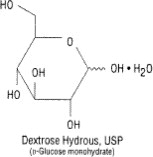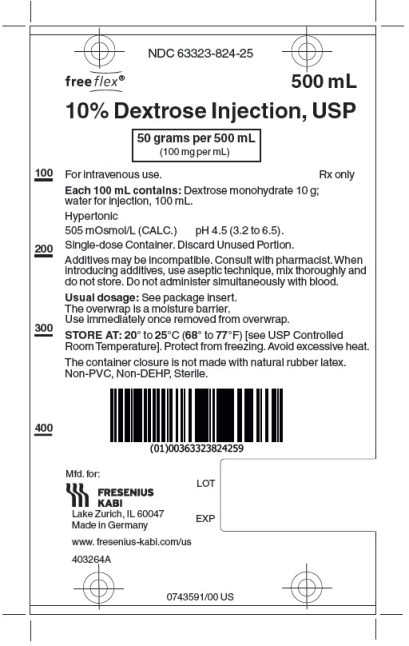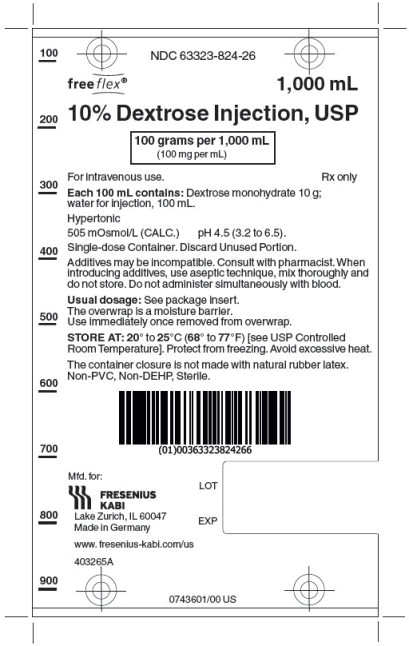FULL PRESCRIBING INFORMATION
2 DOSAGE AND ADMINISTRATION
2.1 Important Administration Instructions
- 10% Dextrose Injection is intended for intravenous use.
- Peripheral administration of 5% dextrose is generally acceptable, however, consider central vein when administering more than 5% dextrose or with an osmolarity of at least 900 mOsm/L or when there is peripheral vein irritation, phlebitis, and/or associated pain [see Warnings and Precautions (5.3)].
- Do not administer 10% Dextrose Injection simultaneously with blood products through the same administration set because of the possibility of pseudoagglutination or hemolysis.
- To prevent air embolism, use a non-vented infusion set or close the vent on a vented set, avoid multiple connections, do not connect flexible containers in series, fully evacuate residual gas in the container prior to administration, do not pressurize the flexible container to increase flow rates, and if administration is controlled by a pumping device, turn off pump before the container runs dry.
- Prior to infusion, visually inspect the diluted dextrose solution for particulate matter. The solution should be clear and there should be no precipitates. Do not administer unless solution is clear and container is undamaged.
- Use of a final filter is recommended during administration of parenteral solutions, where possible.
2.2 Recommended Dosage
The choice of dextrose concentration, rate and volume depends on the age, weight, clinical and metabolic conditions of the patient and concomitant therapy. Electrolyte supplementation may be indicated according to the clinical needs of the patient.
The administration rate should be governed, especially for premature infants with low birth weight, during the first few days of therapy, by the patient's tolerance to dextrose.
Increase the infusion rate gradually as indicated by frequent monitoring of blood glucose concentrations [see Warnings and Precautions (5.1), Use in Specific Populations (8.4)].
2.3 Instructions for Use
Check flexible container solution composition, lot number, and expiry date. Prior to administration, visually inspect for particulate matter and discoloration.
The intact port caps provides visual tamper evidence. Do not use if a port cap is prematurely removed. Do not remove solution container from its overwrap until immediately before use. Use sterile equipment and aseptic technique.
To Open
- Place the solution container on a clean, flat surface. Using the pre-cut corner tabs, peel open the overwrap and remove solution container.
- Check the solution container for leaks by squeezing firmly. If leaks are found, or if the seal is not intact, discard the solution.
- Do not use if the solution is cloudy or a precipitate is present.
To Add Medication
- Identify WHITE Additive Port with arrow pointing toward container.
- Immediately before injecting additives, break off WHITE Additive Port Cap with the arrow pointing toward container.
- Hold base of WHITE Additive Port horizontally.
- Insert needle (18 to 23 gauge) horizontally through the center of WHITE Additive Port's septum and inject additives.
- Mix container contents thoroughly. For high density medication such as potassium chloride, squeeze ports while ports are upright and mix thoroughly.
Preparation for Administration
- Immediately before inserting the infusion set, break off BLUE Infusion Port Cap with the arrow pointing away from container.
- Use a non-vented infusion set or close the air-inlet on a vented set.
- Close the roller clamp of the infusion set.
- Hold the base of BLUE Infusion Port.
- Insert spike through BLUE Infusion Port by rotating wrist slightly until the spike is inserted.
- Suspend solution container from hanger hole
- For Single Use Only. Discard unused portion.
NOTE: See full directions accompanying administration set.
WARNING: Do not use flexible container in series connections.
3 DOSAGE FORMS AND STRENGTHS
10% Dextrose Injection, USP is a clear, sterile, non-pyrogenic solution of dextrose in single-dose flexible plastic containers
- 10% (0.1 grams/mL): 10 grams of dextrose hydrous per 100 mL in flexible plastic containers: 250 mL, 500 mL, and 1000 mL
5 WARNINGS AND PRECAUTIONS
5.1 Hyperglycemia and Hyperosmolar Hyperglycemic State
The use of dextrose infusions in patients with impaired glucose tolerance may worsen hyperglycemia. Administration of dextrose at a rate exceeding the patient's utilization rate may lead to hyperglycemia, coma, and death.
Hyperglycemia is associated with an increase in serum osmolality, resulting in osmotic diuresis, dehydration and electrolyte losses [see Warnings and Precautions (5.5)]. Patients with underlying CNS disease and renal impairment who receive dextrose infusions, may be at greater risk of developing hyperosmolar hyperglycemic state.
Monitor blood glucose levels and treat hyperglycemia to maintain levels within normal limits while administering 10% Dextrose Injection. Insulin may be administered or adjusted to maintain optimal blood glucose levels during 10% Dextrose Injection administration.
5.2 Hypersensitivity Reactions
Hypersensitivity and infusion reactions, including anaphylaxis, have been reported with 10% Dextrose Injection [see Adverse Reactions (6)]. Stop infusion immediately and treat patient accordingly if signs or symptoms of a hypersensitivity reaction develop. Appropriate therapeutic countermeasures must be instituted as clinically indicated.
5.3 Vein Damage and Thrombosis
Peripheral administration of 5% Dextrose Injection is generally acceptable, however, consider central vein when administering more than 5% dextrose or with an osmolarity of ≥ at least 900 mOsm/L or when there is peripheral vein irritation, phlebitis, and/or associated pain [see Dosage and Administration (2.1)].The infusion of hypertonic solutions into a peripheral vein may result in vein irritation, vein damage, and/or thrombosis. The primary complication of peripheral access is venous thrombophlebitis, which manifests as pain, erythema, tenderness or a palpable cord. Remove the catheter as soon as possible, if thrombophlebitis develops.
5.4 Hyponatremia
10% Dextrose Injection is a hypertonic solution [see Description, Table 1 (11)]. In the body, however, glucose containing fluids can become extremely physiologically hypotonic due to rapid glucose metabolization. Monitoring of serum sodium is particularly important for hypotonic fluids.
Depending on the tonicity of the solution, the volume and rate of infusion, and depending on a patient's underlying clinical condition and capability to metabolize glucose, intravenous administration of glucose can cause electrolyte disturbances, most importantly hypo- or hyperosmotic hyponatremia. Monitor serum sodium to minimize the risk of hyponatremia.
The risk for hyponatremia is increased in pediatric patients, elderly patients, postoperative patients, those with psychogenic polydipsia, and in patients treated with medications that increase the risk of hyponatremia (such as diuretics, certain antiepileptic and psychotropic medications). Close clinical monitoring may be warranted.
Acute hyponatremia can lead to acute hyponatremic encephalopathy characterized by headache, nausea, seizures, lethargy and vomiting. Patients with brain edema are at particular risk of severe, irreversible and life-threatening brain injury. Patients at increased risk for developing complications of hyponatremia, such as hyponatremic encephalopathy include pediatric patients; women, in particular, premenopausal women; patients with hypoxemia; and in patients with underlying central nervous system disease [see Use in Specific Populations (8.4, 8.5)].
Avoid Dextrose Injection in patients with or at risk for hyponatremia. If use cannot be avoided, monitor serum sodium concentrations.
Rapid correction of hyponatremia is potentially dangerous with risk of serious neurologic complications. Brain adaptations reducing risk of cerebral edema make the brain vulnerable to injury when chronic hyponatremia is too rapidly corrected, which is known as osmotic demyelination syndrome (ODS). To avoid complications, monitor serum sodium and chloride concentrations, fluid status, acid-base balance, and signs of neurologic complications.
High volume infusion must be used with close monitoring in patients with cardiac or pulmonary failure, and in patients with non-osmotic vasopressin release (including SIADH), due to the risk of hospital-acquired hyponatremia.
5.5 Electrolyte Imbalance and Fluid Overload
Electrolyte deficits, particularly in serum potassium and phosphate, may occur during prolonged use of concentrated dextrose solutions.
Depending on the volume and rate of infusion, the patient's underlying clinical condition and capability to metabolize dextrose, intravenous administration of 10% Dextrose Injection can cause fluid and/or solute overloading resulting in dilution of serum electrolyte concentrations, (including hypoosmotic hyponatremia), overhydration, congested states or pulmonary edema. The risk of dilutional states is inversely proportional to the electrolyte concentrations in the administered solution. The risk of solute overload causing congested states with peripheral and pulmonary edema is directly proportional to the electrolyte concentrations in the solution.
Avoid Dextrose Injection in patients with or at risk for fluid and/or solute overloading. If use cannot be avoided, monitor fluid balance, blood electrolyte levels, concentration of glucose, acid-base balance, correct fluid and electrolyte imbalances during prolonged parenteral therapy or whenever the condition of the patient or the rate of administration warrants such evaluation and acid-base balance as needed and especially during prolonged use. Additional monitoring is recommended for patients with water and electrolyte disturbances that could be aggravated by increased glucose, insulin administration and/or free water load. Patients at increased risk for developing hyponatremic encephalopathy include pediatric patients; elderly patients, women, in particular premenopausal women; patients with hypoxemia; and patients with underlying CNS disease [see Use in Specific Populations (8.4, 8.5)].
5.6 Refeeding Syndrome
Refeeding severely undernourished patients may result in refeeding syndrome, characterized by the intracellular shift of potassium, phosphorus, and magnesium as the patient becomes anabolic. Thiamine deficiency and fluid retention may also develop. To prevent these complications, monitor severely undernourished patients and slowly increase nutrient intake.
6 ADVERSE REACTIONS
The following adverse reactions associated with the use of dextrose injection were identified in clinical trials or postmarketing reports. Because these reactions were reported voluntarily from a population of uncertain size, it is not always possible to estimate their frequency, reliably, or to establish a causal relationship to drug exposure.
The following clinically significant adverse reactions are described elsewhere in the labeling:
- Hyperglycemia and hyperosmolar hyperglycemic state [see Warnings and Precautions (5.1)]
- Hypersensitivity Reactions: anaphylaxis, pruritus, bronchospasm, cyanosis, angioedema, hypotension, pyrexia, chills, and rash [see Warnings and Precautions (5.2)]
- Infusion Site Reactions: infusion site phlebitis, infusion site erythema, vein damage and thrombosis, and infusion site thrombophlebitis [see Warnings and Precautions (5.3)]
- Hyponatremia and hyponatremic encephalopathy [see Warnings and Precautions (5.4)]
- Electrolyte imbalance, fluid overload and hypervolemia [see Warnings and Precautions (5.5)]
- Refeeding syndrome [see Warnings and Precautions (5.6)]
- Pulmonary vascular precipitates
7 DRUG INTERACTIONS
7.1 Other Products that Affect Glycemic Control, Vasopressin or Fluid and/or Electrolyte Balance
Dextrose Injection can affect glycemic control, vasopressin and fluid and/or electrolyte balance [see Warnings and Precautions (5.1, 5.4, 5.5)]. Monitor blood glucose concentrations, fluid balance, serum electrolyte concentrations and acid-base balance when using Dextrose Injection in patients treated with other substances that affect glycemic control, vasopressin or fluid and/or electrolyte balance.
8 USE IN SPECIFIC POPULATIONS
8.1 Pregnancy
Risk Summary
Appropriate administration of 10% Dextrose Injection during pregnancy is not expected to cause adverse developmental outcomes, including congenital malformations. Animal reproduction studies have not been conducted with injectable dextrose solutions.
The estimated background risk of major birth defects and miscarriage for the indicated population is unknown. All pregnancies have a background risk of birth defect, loss, or other adverse outcomes. In the U.S. general population, the estimated background risk of major birth defects and miscarriage in clinically recognized pregnancies is 2 to 4% and 15 to 20%, respectively.
8.2 Lactation
Risk Summary
There are no data on the presence of dextrose in human milk, the effects on a breastfed infant, or the effects on milk production. The lack of clinical data during lactation precludes a clear determination of the risk of 10% Dextrose Injection to an infant during lactation; therefore, the developmental and health benefits of breastfeeding should be considered along with the mother's clinical need for 10% Dextrose Injection and any potential adverse effects on the breastfed infant from 10% Dextrose Injection or from the underlying maternal condition.
8.4 Pediatric Use
The safety profile of 10% Dextrose Injection in pediatric patients is similar to adults.
Neonates, especially premature infants with low birth weight, are at increased risk of developing hypo- or hyperglycemia and therefore need close monitoring during treatment with intravenous glucose infusions to ensure adequate glycemic control in order to avoid potential long-term adverse effects.
Closely monitor plasma electrolyte concentrations in pediatric patients who may have impaired ability to regulate fluids and electrolytes. In very low birth weight infants, excessive or rapid administration of 10% Dextrose Injection may result in increased serum osmolality and risk of intracerebral hemorrhage.
Children (including neonates and older children) are at increased risk of developing hyponatremia as well as for developing hyponatremic encephalopathy [see Warnings and Precautions (5.4)].
8.5 Geriatric Use
Clinical studies of 10% Dextrose Injection did not include sufficient numbers of subjects aged 65 and over to determine whether they respond differently from younger subjects. Elderly patients are at increased risk of developing hyponatremia as well as for developing hyponatremic encephalopathy [see Warnings and Precautions (5.4)]. Other reported clinical experience has not identified differences in responses between the elderly and younger patients. In general, dose selection for an elderly patient should be cautious, usually starting at the low end of the dosing range, reflecting the greater frequency of decreased hepatic, renal, or cardiac function, and of concomitant disease or other drug therapy.
Dextrose is known to be substantially excreted by the kidney, and the risk of toxic reactions to this drug may be greater in patients with impaired renal function. Because elderly patients are more likely to have decreased renal function, care should be taken in dose selection, and it may be useful to monitor renal function.
10 OVERDOSAGE
An increased infusion rate of 10% Dextrose Injection or administration of dextrose solutions can cause hyperglycemia, hyperosmolality, and adverse effects on water and electrolyte balance [see Warnings and Precautions (5.1, 5.5)].
Severe hyperglycemia and severe dilutional hyponatremia, and their complications, can be fatal. Discontinue infusion, reduce dose and institute appropriate corrective measures such as administration of exogenous insulin.
Discontinue infusion and institute appropriate corrective measures in the event of overhydration or solute overload during therapy, with particular attention to CNS, respiratory and cardiovascular systems.
If over-exposure occurs, call your Poison Control Center at 1-800-222-1222 for current information on the management of poisoning or overdosage.
11 DESCRIPTION
10% Dextrose Injection, USP is a sterile, non-pyrogenic solution for fluid replenishment and caloric supply in single dose containers for intravenous administration.
The solution contains no bacteriostatic, antimicrobial agent or added buffer and is intended only for use as a single-dose injection. The pH range is 4.0 (3.2 to 6.5)
|
*Caloric value calculated on the basis of 3.4 kcal/g of dextrose, hydrous |
||||
| Strength | Fill Volume | Amount of Dextrose Hydrous per Container | kcal* per Container | Osmolarity
(mOsmol per liter) |
| Dextrose Injection 10%, USP (0.1 grams/mL) | 250 mL | 25 grams | 85 | 505 |
| 500 mL | 50 grams | 170 | 505 | |
| 1000 mL | 100 grams | 340 | 505 | |
Dextrose, USP is chemically designated D-glucose, monohydrate (C6H12O6 • H2O), a hexose sugar freely soluble in water. The molecular weight of dextrose (D-glucose) monohydrate is 198.17. It has the following structural formula:
Water for Injection, USP is chemically designated H2O.
Dextrose is derived from corn.
The flexible container is fabricated from a specially formulated non-plasticized, film containing polypropylene and thermoplastic elastomers (freeflex® bag). The amount of water that can permeate from the container into the overwrap is insufficient to affect the solution significantly. Solutions in contact with the flexible container can leach out certain of the container's chemical components in very small amounts within the expiration period. The suitability of the container material has been confirmed by tests in animals according to USP biological tests for plastic containers.
The flexible container is a closed system, and air is prefilled in the container to facilitate drainage. The container does not require entry of external air during administration.
The container has two ports: one is the administration outlet port for attachment of an intravenous administration set and the other port has a medication site for addition of supplemental medication ([see Instructions for Use (2.3)]). The primary function of the overwrap is to protect the container from the physical environment.
16 HOW SUPPLIED/STORAGE AND HANDLING
10% Dextrose Injection, USP is supplied in single dose flexible plastic containers as follows:
| Product Number | Unit of Sale | Strength | Each |
| 824174 | 63323-824-74 Package of 30 freeflex® bag | 25 grams per 250 mL (100 mg per mL) | NDC 63323-824-24 One 250 mL freeflex® bag |
| 824175 | 63323-824-75 Package of 20 freeflex® bag | 50 grams per 500 mL (100 mg per mL) | NDC 63323-824-25 One 500 mL freeflex® bag |
| 824176 | 63323-824-76 Package of 10 freeflex® bag | 100 grams per 1,000 mL (100 mg per mL) | NDC 63323-824-26 One 1000 mL freeflex® bag |
Exposure of pharmaceutical products to heat should be minimized. Avoid excessive heat.
17 PATIENT COUNSELING INFORMATION
Inform patients, caregivers, or home healthcare providers of the following risks of 10% Dextrose Injection:
- Hyperglycemia and hyperosmolar hyperglycemic state [see Warnings and Precautions (5.1)]
- Hypersensitivity reactions [see Warnings and Precautions (5.2)]
- Vein damage and thrombosis [see Warnings and Precautions (5.3)]
- Hyponatremia [see Warnings and Precautions (5.4)]
- Electrolyte imbalance and fluid overload [see Warnings and Precautions (5.5)]
- Refeeding syndrome [see Warnings and Precautions (5.6)]
Manufactured for:
Lake Zurich, IL 60047
Made in Germany
www.fresenius-kabi.com/us
451516B
PACKAGE LABEL - PRINCIPAL DISPLAY PANEL - 10% Dextrose Bag Label
NDC 63323-824-24
free
flex
® 250 mL
10% Dextrose Injection, USP
25 grams per 250 mL (100 mg per mL)
For intravenous use. Rx only




